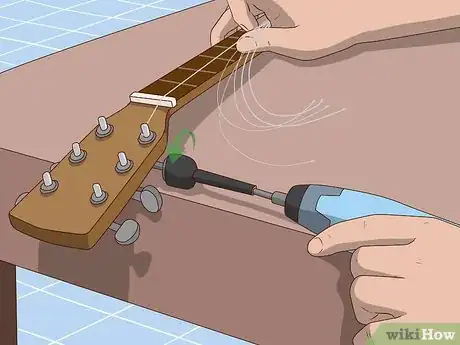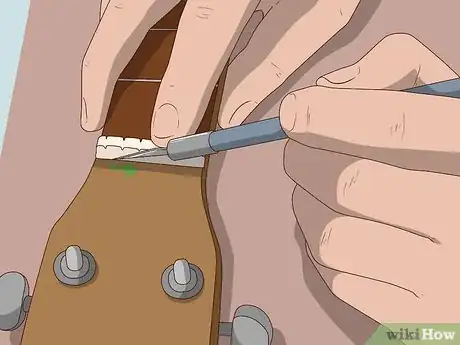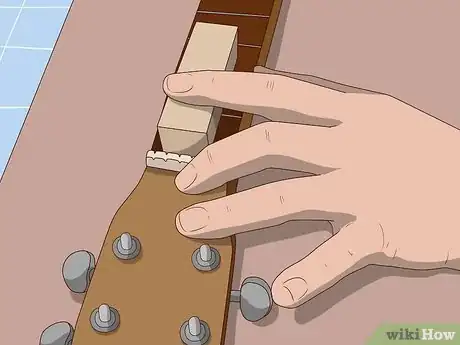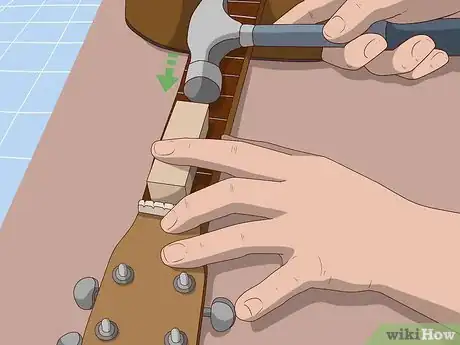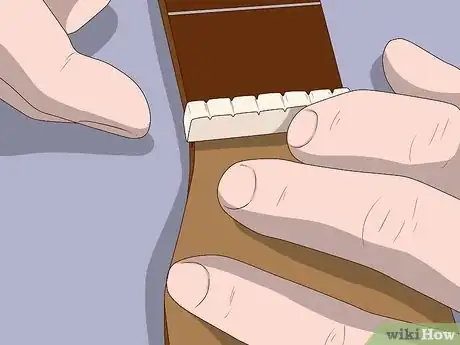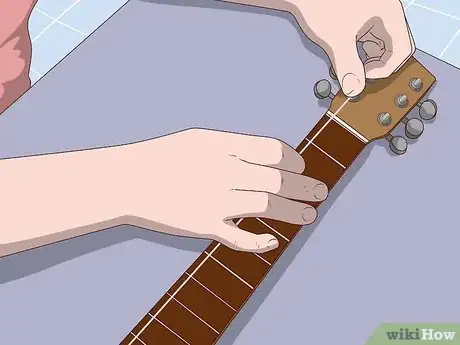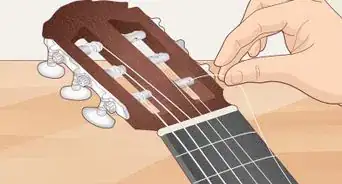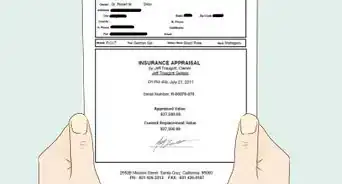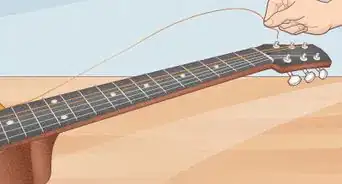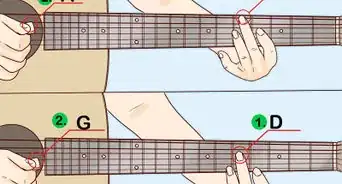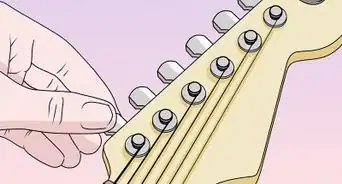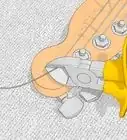This article was co-authored by Aaron Asghari. Aaron Asghari is a Professional Guitarist and the lead guitarist of The Ghost Next Door. He received his degree in Guitar Performance from the Guitar Institute of Technology program in Los Angeles. In addition to writing and performing with The Ghost Next Door, he is the founder and primary guitar instructor of Asghari Guitar Lessons.
There are 8 references cited in this article, which can be found at the bottom of the page.
wikiHow marks an article as reader-approved once it receives enough positive feedback. In this case, 92% of readers who voted found the article helpful, earning it our reader-approved status.
This article has been viewed 49,374 times.
A guitar nut is located at the end of the fingerboard where the fingerboard meets the headstock. It holds the strings in slots and defines the string spacing for the guitar. You might need to replace the guitar nut on your guitar if the slots get worn out, it breaks, if you are changing the size of the strings or their spacing, or if you want to replace a poor-sounding plastic guitar nut. In order to do so, you need a pre-slotted drop-in replacement nut and some basic tools. To replace the nut, you first need to remove the old nut, then you can drop the new nut in and make minor adjustments until it fits just right.
Things You Should Know
- Remove all the strings and use a craft knife to score the nut.
- Use a wood block and a small hammer or mallet to remove the old nut.
- Sand down your new nut using 800- or 1000-grit sandpaper until it fits in the slot on your guitar.
- Secure the new nut with glue and restring your guitar when you’re done.
Steps
Removing the Old Nut
-
1Remove all the guitar strings so you can access the guitar nut. Loosen the tension of each string with the tuning keys and unwind each string from its tuning post. Pull out each bridge pin that holds the strings to the bridge at the bottom of the guitar with needle-nose pliers and pull each string out. Remove the strings and set them aside.[1]
- You can take advantage of this opportunity to put new strings on your guitar since you already have to remove them to replace the guitar nut.
-
2Use a craft knife with a fresh, sharp blade to score around the guitar nut. Trace the finish around all the edges of the nut with the tip of the craft knife to prevent lacquer from sticking to the nut when you knock it loose. Trace around each edge of the nut where it meets the wood of the headstock 2-3 times.[2]
- This will help free the nut from the lacquer and any glue that may have been used around it to prevent chipping and breaking of the wood around it when you knock it loose.
- Be careful when using a craft knife not to cut yourself.
Advertisement -
3Place a small wooden block against the long back edge of the nut. Use a wooden block approximately the width of the guitar nut and thick enough that you can hit the back edge with a hammer. Place it on top of the fingerboard against the long edge of the nut where it meets the wood of the fingerboard.[3]
- The wooden block will help distribute the pressure of your hammer blows to knock the guitar nut loose all at once and avoid damaging the wood around it.
-
4Tap the back edge of the block lightly with a hammer to knock the nut loose. Hold the wooden block in place against the long edge of the nut with 1-2 fingers of your non-dominant hand. Carefully wield a hammer with your dominant hand and gently tap the back edge of the wooden block to knock the nut free from the wood of the fingerboard.[4]
- Ideally, this will only take 1 light tap. If the guitar nut doesn’t come free after 1-2 light taps, try scoring around the edges more with your craft knife. Don’t try to make it come loose by swinging the hammer harder or you might damage your guitar.
Tip: If you can’t get the nut out of the slot, you can try tapping it out sideways by holding the tip of a flathead screwdriver against 1 side of the nut and hitting the back of the screwdriver lightly with your hammer to slide the nut out sideways.
Adjusting and Dropping in the New Nut
-
1Test how the new guitar nut fits where the old nut was. Try to fit a new pre-slotted drop-in nut where the old nut sat against the wood of the fingerboard. Look closely at how it sits and decide how much shorter you need to make it.[5]
- Keep in mind that the strings need to be able to clear the first fret so they don't buzz against it. Try to compare your new nut to the old nut and make it approximately the same height if the old height was good. When in doubt, a little taller is better than too short.
- You can get new pre-slotted drop-in guitar nuts online or at a music store.
-
2Sand down the new guitar nut with 800- or 1000-grit sandpaper until it fits. Place a piece of sandpaper on a flat work surface and secure it with masking tape. Sand the bottom of the nut a little bit at a time, testing it on the guitar as you go, and stop when you are happy with the height and fit.[6]
- Remove only a small amount of material at a time from the nut. If you remove too much, the slots of the guitar nut will be too close to the wood of the fingerboard and the strings will be too close to the first fret.
- Evenly sand the ends of the guitar nut if there is any overhang. Remove only a bit at a time until there is little to no overhang when the nut is resting in the slot.
-
3Secure the new nut in place with glue when you are happy with the fit. Squeeze out 2 small dabs of wood glue onto the underside of the nut. Fit it carefully into the slot and press it firmly into place. Leave it to dry for 24 hours.[7]
- It’s not recommended to use permanent glue, such as superglue, to attach a guitar nut because it will make it very hard to remove and can result in damage to your guitar if you ever want to replace it again.
-
4Color in the string slots with the tip of a graphite pencil. Use a regular wood and graphite pencil, like the yellow kind, to color in each string slot on the new guitar nut. This helps keep the strings from getting caught up in the new nut as you install them.[8]
- If you are reinstalling the old strings, this would also be a good time to clean them.
-
5Restring the guitar with the old strings or new ones. Put the bottom ends of the strings back into the bridge, secure them with the bridge pins, and wind the top ends around the tuning posts. Tighten the tension of the strings using the tuning posts and tune the guitar to the correct pitch.[9]
- You can check the height of the strings by pressing down on the third note of the top string and seeing if there is a gap between the string and the first fret of about 25 mm (0.010 inches), or slightly less than the thickness of a credit card. If so, then your strings are resting at a good height.
Expert Q&A
Did you know you can get expert answers for this article?
Unlock expert answers by supporting wikiHow
-
QuestionHow does a Floyd Rose bridge work?
 Aaron AsghariAaron Asghari is a Professional Guitarist and the lead guitarist of The Ghost Next Door. He received his degree in Guitar Performance from the Guitar Institute of Technology program in Los Angeles. In addition to writing and performing with The Ghost Next Door, he is the founder and primary guitar instructor of Asghari Guitar Lessons.
Aaron AsghariAaron Asghari is a Professional Guitarist and the lead guitarist of The Ghost Next Door. He received his degree in Guitar Performance from the Guitar Institute of Technology program in Los Angeles. In addition to writing and performing with The Ghost Next Door, he is the founder and primary guitar instructor of Asghari Guitar Lessons.
Professional Guitarist & Instructor
Things You’ll Need
Removing the Old Nut
- Needle-nose pliers
- Craft knife
- Small wooden block
- Hammer
Dropping in the New Nut
- New pre-slotted drop-in guitar nut
- Sandpaper (800- or 1000-grit)
- Masking tape
- Superglue
References
- ↑ https://www.youtube.com/watch?v=S6lGTSGaSOo&feature=youtu.be&t=35
- ↑ https://www.youtube.com/watch?v=S6lGTSGaSOo&feature=youtu.be&t=40
- ↑ https://www.youtube.com/watch?v=S6lGTSGaSOo&feature=youtu.be&t=65
- ↑ https://www.youtube.com/watch?v=S6lGTSGaSOo&feature=youtu.be&t=67
- ↑ https://guitar.com/guides/diy-workshop/how-to-replace-guitar-nut/
- ↑ https://guitar.com/guides/diy-workshop/how-to-replace-guitar-nut/
- ↑ http://www.fretnotguitarrepair.com/repair/acoustic-guitar/nut.php
- ↑ https://www.youtube.com/watch?v=S6lGTSGaSOo&feature=youtu.be&t=150
- ↑ https://www.youtube.com/watch?v=QSc54J1HwBY&feature=youtu.be&t=94
